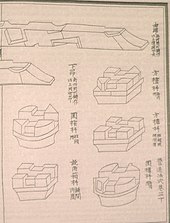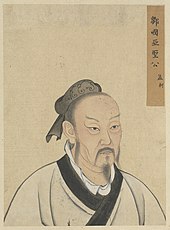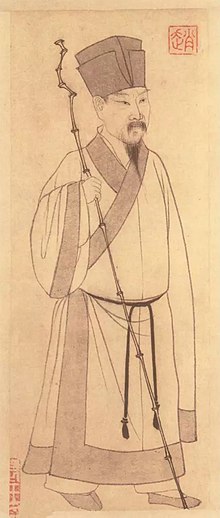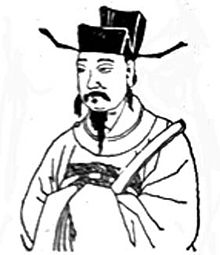Shen Kuo
[7] Alongside his colleague Wei Pu, Shen planned to map the orbital paths of the Moon and the planets in an intensive five-year project involving daily observations, yet this was thwarted by political opponents at court.
[8] To aid his work in astronomy, Shen Kuo made improved designs of the armillary sphere, gnomon, sighting tube, and invented a new type of inflow water clock.
Shen Kuo devised a geological hypothesis for land formation (geomorphology), based upon findings of inland marine fossils, knowledge of soil erosion, and the deposition of silt.
His father Shen Zhou (沈周; 978–1052) was a somewhat lower-class gentry figure serving in official posts on the provincial level; his mother was from a family of equal status in Suzhou, with her maiden name being Xu (許).
[11] Since Shen was unable to boast of a prominent familial clan history like many of his elite peers born in the north, he was forced to rely on his wit and stern determination to achieve in his studies, subsequently passing the imperial examinations and enter the challenging and sophisticated life of an exam-drafted state bureaucrat.
[13] With his leadership position in the bureau, Shen was responsible for projects in improving calendrical science,[10] and proposed many reforms to the Chinese calendar alongside the work of his colleague Wei Pu.
"[18] While employed by the central government, Shen Kuo was also sent out with others to inspect the granary system of the empire, investigating problems of illegal tax-collection, negligence, ineffective disaster relief, and inadequate water-conservancy projects.
[22] In regard to the Lý dynasty of Đại Việt (in modern northern Vietnam), Shen demonstrated in his Dream Pool Essays that he was familiar with the key players (on the Vietnamese side) in the prelude to the Sino-Vietnamese War of 1075–1077.
In the 1070s, Shen had purchased a lavish garden estate on the outskirts of modern-day Zhenjiang, Jiangsu province, a place of great beauty which he named "Dream Brook" ("Mengxi") after he visited it for the first time in 1086.
[32] Joseph Needham suggests that certain pottery vessels of the Han dynasty (202 BC – 220 AD) showing artificial mountains as lid decorations may have influenced the development of the raised-relief map in China.
[38] In the realms of botany, zoology, and mineralogy, Shen Kuo documented and systematically described hundreds of different plants, agricultural crops, rare vegetation, animals, and minerals found in China.
[47][48] However, he did not anticipate the more complex and matured system of unit proportions embodied in the extensive written work by scholar-official Li Jie (1065–1110), the Treatise on Architectural Methods (營造法式; Yingzao Fashi) of 1103.
[61] Shen wrote extensively about what he had learned while working for the state treasury, including mathematical problems posed by computing land tax, estimating requirements, currency issues, metrology, and so forth.
[6] The preference of use for the twenty-four-point-rose compass may have arisen from Shen's finding of a more accurate astronomical meridian, determined by his measurement between the pole star and true north;[6] however, it could also have been inspired by geomantic beliefs and practices.
"[81] While working in the Bureau of Astronomy, Shen Kuo's interest in archaeology and old relics led him to reconstruct an armillary sphere from existing models as well as from ancient texts that could provide additional information.
[90] Shen wrote that in the Zhiping reign period (1064–1067) a man of Zezhou unearthed an object in his garden that looked like a serpent or dragon, and after examining it, concluded the dead animal had apparently turned to "stone".
[93] Considering that damp and gloomy low places provide suitable conditions for the growth of bamboo, Shen deduced that the climate of Yanzhou must have fit that description in very ancient times.
[103] The philosopher Wang Chong argued against the 'radiating influence' theory of Jing Fang's writing in the 1st century BC and that of Zhang Heng (78–139); the latter two correctly hypothesized that the brightness of the Moon was merely light reflected from the Sun.
"[112] Along with his colleague Wei Pu in the Bureau of Astronomy, Shen Kuo planned to plot out the exact coordinates of planetary and lunar movements by recording their astronomical observations three times a night for a continuum of five years.
[114] Shen Kuo wrote that during the Qingli reign period (1041–1048), under Emperor Renzong of Song (1022–1063), an obscure commoner and artisan known as Bi Sheng (990–1051) invented ceramic movable type printing.
[121] Yao Shu (1201–1278), an advisor to Kublai Khan, once persuaded a disciple Yang Gu to print philological primers and Neo-Confucian texts by using what he termed the "movable type of Shen Kuo".
While visiting the iron-producing district at Cizhou in 1075, Shen described the "partial decarburization" method of reforging cast iron under a cold blast, which Hartwell, Needham, and Wertime state is the predecessor of the Bessemer process.
[130] Shen was worried about deforestation[f] due to the needs of the iron industry and ink makers using pine soot in the production process, so he suggested for the latter an alternative of petroleum, which he believed was "produced inexhaustibly within the earth".
[134] Nathan Sivin proposes that Shen was the first in history to "make a clear distinction between our unconnected experiences and the unitary causal world we postulate to explain them," which Biderman and Scharfstein state is arguably inherent in the works of Heraclitus, Plato, and Democritus as well.
[137] When describing an event where lightning had struck a house and all the wooden walls did not burn (but simply turned black) and lacquerwares inside were fine, yet metal objects had melted into liquid, Shen Kuo wrote: Most people can only judge of things by the experiences of ordinary life, but phenomena outside the scope of this are really quite numerous.
[138]In his commentary on the ancient Confucian philosopher Mencius (372–289 BC), Shen wrote of the importance of choosing to follow what one knew to be a true path, yet the heart and mind could not attain full knowledge of truth through mere sensory experience.
In 1075, Shen Kuo wrote the Xining Fengyuan Li (熙寧奉元曆; The Oblatory Epoch astronomical system of the Splendid Peace reign period), which was lost, but listed in a 7th chapter of a Song dynasty bibliography.
[162] In the Routledge Curzon Encyclopedia of Confucianism, Xinzhong Yao states that Shen Kuo's legacy was tainted by his eager involvement in Wang Anshi's New Policies reforms, his actions criticized in the later traditional histories.
"[167] Huff writes that this was a systemic problem of early Chinese science, which lacked systematic treatment that could be found in European works such as the Concordance and Discordant Canons by the lawyer Gratian of Bologna (fl.
[171] In this exhibition hall there stands a 1.4 m (4.6 ft) tall statue of Shen Kuo sitting on a platform, along with centuries-old published copies of his Dream Pool Essays in glass cabinets, one of which is from Japan.






















